
Rendering is the process of generating a photorealistic or non-photorealistic image from input data such as 3D models. The word "rendering" originally meant the task performed by an artist when depicting a real or imaginary thing. Today, to "render" commonly means to generate an image or video from a precise description using a computer program.

A render farm is a high-performance computer system, e.g. a computer cluster, built to render computer-generated imagery (CGI), typically for film and television visual effects.

Blender is a free and open-source 3D computer graphics software tool set that runs on Windows, macOS, BSD, Haiku, IRIX and Linux. It is used for creating animated films, visual effects, art, 3D-printed models, motion graphics, interactive 3D applications, and virtual reality. It is also used in creating video games.
X3D is a set of royalty-free ISO/IEC standards for declaratively representing 3D computer graphics. X3D includes multiple graphics file formats, programming-language API definitions, and run-time specifications for both delivery and integration of interactive network-capable 3D data. X3D version 4.0 has been approved by Web3D Consortium, and is under final review by ISO/IEC as a revised International Standard (IS).
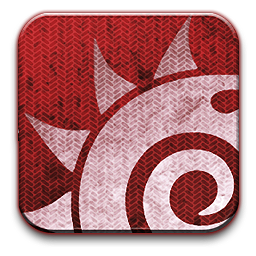
LightWave 3D is a 3D computer graphics program developed by LightWave Digital. It has been used in films, television, motion graphics, digital matte painting, visual effects, video game development, product design, architectural visualizations, virtual production, music videos, pre-visualizations and advertising.
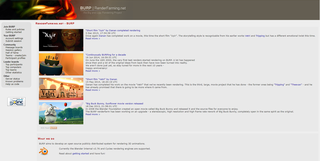
Big and Ugly Rendering Project (BURP) is a non-commercial volunteer computing project using the BOINC framework for the rendering of 3D graphics that has been in hibernation as of 2020. The project website currently shows the status as "extended maintenance" until 2027.
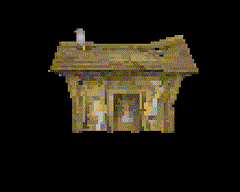
Software rendering is the process of generating an image from a model by means of computer software. In the context of computer graphics rendering, software rendering refers to a rendering process that is not dependent upon graphics hardware ASICs, such as a graphics card. The rendering takes place entirely in the CPU. Rendering everything with the (general-purpose) CPU has the main advantage that it is not restricted to the (limited) capabilities of graphics hardware, but the disadvantage is that more transistors are needed to obtain the same speed.

The Blender Foundation is a Dutch nonprofit organization (Stichting) responsible for the development of Blender, an open-source 3D content-creation program.

Vue is a software tool for world generation by Bentley Systems with support for many visual effects, animations and various other features. The tool has been used in several feature-length movies.
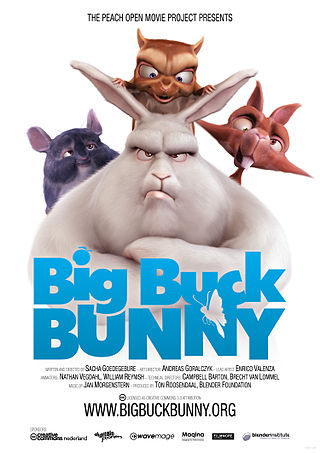
Big Buck Bunny is a 2008 animated comedy short film featuring animals of the forest, made by the Blender Institute, part of the Blender Foundation. Like the foundation's previous film, Elephants Dream, the film was made using Blender, a free and open-source software application for 3D computer modeling and animation developed by the same foundation. Unlike that earlier project, the tone and visuals departed from a cryptic story and dark visuals to one of comedy, cartoons, and light-heartedness.

Ton Roosendaal is a Dutch software developer and film producer. He is the original creator of the open-source 3D creation suite Blender and Traces. He is also known as the founder and chairman of the Blender Foundation, and for pioneering large scale open-content projects. In 2007, he established the Blender Institute in Amsterdam, where he works on coordinating Blender development, publishing manuals and DVD training, and organizing 3D animation and game projects.
Multi View Video Coding is a stereoscopic video coding standard for video compression that allows for encoding video sequences captured simultaneously from multiple camera angles in a single video stream. It uses the 2D plus Delta method and it is an amendment to the H.264 video compression standard, developed jointly by MPEG and VCEG, with the contributions from a number of companies, such as Panasonic and LG Electronics.

Sintel is a 2010 animated fantasy short film. It was the third Blender "open movie". It was produced by Ton Roosendaal, chairman of the Blender Foundation, written by Esther Wouda, directed by Colin Levy, at the time an artist at Pixar and art direction by David Revoy, who is known for Pepper&Carrot, a free and open source webcomic series. It was made at the Blender Institute, part of the Blender Foundation. The plot follows the character, Sintel, who is tracking down her pet Scales, a dragon. Just like the other Blender "open movies," the film was made using Blender, a free and open source software application for animation, created and supported by the Blender Foundation.

Away3D is an open-source platform for developing interactive 3D graphics for video games and applications, in Adobe Flash or HTML5. The platform consists of a 3D world editor, a 3D graphics engine, a 3D physics engine and a compressed 3D model file format (AWD).
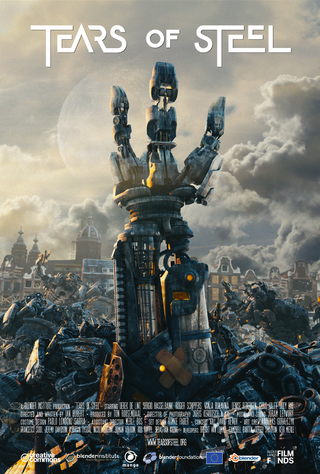
Tears of Steel is a short science fiction film by producer Ton Roosendaal and director/writer Ian Hubert. The film is both live-action and CGI; it was made using new enhancements to the visual effects capabilities of Blender, a free and open-source 3D computer graphics app. Set in a dystopian future, the short film features a group of warriors and scientists who gather at the Oude Kerk in Amsterdam in a desperate attempt to save the world from destructive robots.

A stereoscopic video game is a video game which uses stereoscopic technologies to create depth perception for the player by any form of stereo display. Such games should not be confused with video games that use 3D game graphics on a mono screen, which give the illusion of depth only by monocular cues but lack binocular depth information.

Natron is a free and open-source node-based compositing application. It has been influenced by digital compositing software such as Avid Media Illusion, Apple Shake, Blackmagic Fusion, Autodesk Flame and Nuke, from which its user interface and many of its concepts are derived.

Cosmos Laundromat: First Cycle, developed under the code name Project Gooseberry, is an animated absurdist sci-fi fantasy short film directed by Mathieu Auvray, written by Esther Wouda, and produced by Ton Roosendaal. It is the Blender Institute's 5th "open movie" project, and was made utilizing the Blender software. The film focuses around a depressed and suicidal sheep named Franck who is offered "all the lives he ever wanted" by a mysterious salesman named Victor. On August 10, 2015, it was released to YouTube. The film was originally intended to kickstart a feature-length film. A short film sequel was written and designed but never brought to production. In 2020, Roosendaal announced that the one film would be the total of the project.














